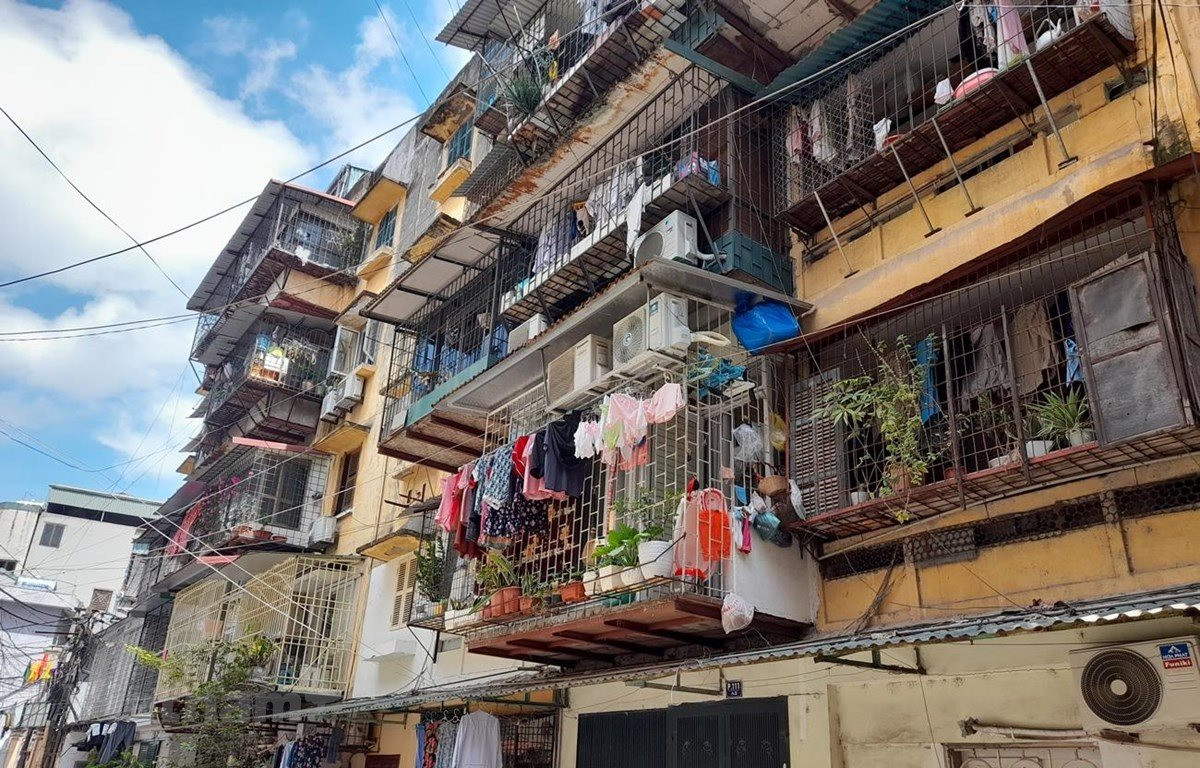
By the end of 2023, Hanoi has only achieved about 1% of its goal of renovating old apartment buildings.
“Decades-long” problem
According to the statistics of the Hanoi Department of Construction, there are about 1,500 old apartment buildings in the city, most of which have exceeded their lifespan, seriously degraded, and no longer meet the living needs of residents. At the end of 2021, the Hanoi People’s Committee issued a plan to renovate and rebuild old apartment buildings in the city and implemented the plan. However, after more than 2 years, the renovation and reconstruction of old apartment buildings in the city is still slow and faces many difficulties.
According to the leaders of the Hanoi Department of Construction, in 2023, the Department has reviewed, urged, and guided the investors of 11 renovation and reconstruction projects for old apartment buildings, but only 2 projects have completed construction and put into operation, including the 3A Quang Trung apartment building (Trang Tien ward, Hoan Kiem district) and the renovation project for the L1 and L2 old apartment buildings (93 Lang Ha street, Dong Da district).
Therefore, by the end of 2023, the whole city has only completed the renovation and reconstruction of 19 old collective housing areas and apartment buildings, accounting for 1.14% of the total workload. Many projects are still being promoted, such as the renovation and reconstruction project for Nguyen Cong Tru collective housing area (Hai Ba Trung district); A & B Nghia Do buildings (Cau Giay district); X1 collective housing area (26 Lieu Giai street, Ba Dinh district); Railway Transport Service residential area (Hoang Mai district); 148 – 150 Son Tay apartment buildings (Ba Dinh district); Vietnam Film Archives Institute – The Boulevard collective housing area (22 Lieu Giai street, Ba Dinh district); demolition and new construction project at 225 Thuy Khue street (Tay Ho district); 23 Hang Bai project (Hoan Kiem district)…
“Reaching a compensation agreement between investors and owners is difficult because the owners often demand a high compensation coefficient, especially for households on the 1st floor, which makes it difficult for investors to balance the financial efficiency of the project. This is one of the major obstacles affecting the progress of the renovation and reconstruction of old apartment buildings in the city,” said Bui Tien Thanh, Head of the Urban Development Department (Hanoi Department of Construction).
Putting the burden on districts
According to Mac Dinh Minh, Deputy Director of the Hanoi Department of Construction, in 2023, the Department has developed a method to determine the compensation coefficient and worked with all districts and towns with old apartment buildings to provide guidance. However, the implementation process faces many difficulties because each old apartment building has a different location; planning and population density are also different.
In order to overcome these difficulties in the renovation of old apartment buildings, the Steering Committee for the Renovation and Reconstruction of Old Apartment Buildings in the city has agreed to delegate and decentralize the authority to districts and towns with old apartment buildings to determine the compensation coefficient according to the Department of Construction’s guidelines.
According to the Hanoi Department of Construction, at the end of 2023, the Department has submitted a proposal along with a draft decision to authorize districts and towns with old apartment buildings to approve the compensation coefficient when implementing the renovation and reconstruction of old apartment buildings within their management area, in accordance with the approved planning, ensuring the interests of the state, the people, and the investors.
However, according to experts, decentralizing the determination of the compensation coefficient to districts and towns may put the burden on them in the renovation of old apartment buildings.
Specifically, districts and towns can determine a higher compensation support coefficient (K coefficient) according to the wishes of the residents, but then it will be difficult to attract businesses to participate in the renovation of old apartment buildings because it does not guarantee the business equation as the post-renovation works must comply with the planning restrictions.
In addition, in the case of renovation projects for old apartment buildings using state budget capital, the determination of the compensation coefficient has not been regulated or specifically guided, making it difficult to gain the consensus of the people.
Experts believe that without a suitable mechanism for determining the compensation coefficient that ensures the balance of the interests of the state, the people, and the businesses, the “obstacle” named the compensation coefficient will still exist.
Therefore, the issues related to the compensation coefficient that are beyond the authority of higher levels such as the provincial and city People’s Committees or the Department of Construction have been difficult to solve and may still pose challenges for districts and towns.
The reality shows that not only in Hanoi but also in other localities in recent years, despite the efforts to promote the construction and renovation of old apartment buildings and the issuance of new policies to simplify procedures for compensation, land clearance, and investment, many big real estate companies have requested to renovate old apartment buildings but have been unsuccessful due to the unresolved compensation issue.
Nguyen Quoc Hiep, Chairman of the Vietnam Association of Construction Contractors (VACC), shared that the current compensation coefficient according to Decree 69/2021/NĐ-CP is determined from 1-2 times, but there is no specific guidance on what is 1, what is 2, what is 1.5 or 1.7, and what the conditions are, so it is very difficult to negotiate with residents.
“With such a coefficient, the area to be returned for resettlement is very large, conflicting with the planning targets set by the City such as height restrictions and population density. This is a difficult problem that needs to be changed,” said Hiep.









































